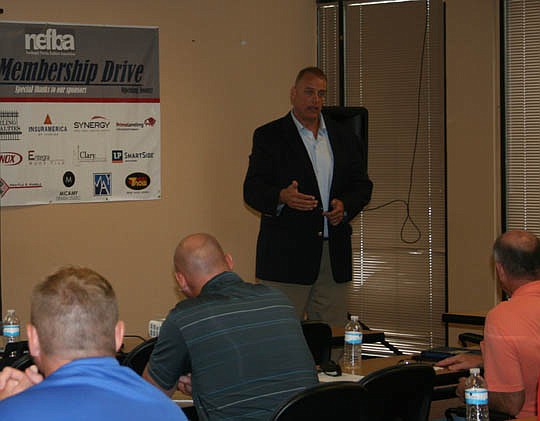
By Kevin Hogencamp, Contributing Writer
From falling off roofs to breathing in asbestos, construction workers are exposed to many hazards on the job.
In Jacksonville, workers have been killed on the job by a steer loader bucket, a concrete panel and gunshots.
Also, by falling through a skylight and after slipping in a meat cooler.
All since November 2014.
Many worksplace deaths and injuries are preventable, especially on construction sites.
That message was sternly delivered last month to the Northeast Florida Builders Association by Brian Sturtecky, the Occupational Safety and Health Administration’s Jacksonville-area director.
OSHA is a U.S. Department of Labor agency created in 1970 to assure safe and healthful conditions in the workplace, in addition to enforcing whistleblower laws.
Federal workplace safety laws and regulations cover most private sector employers and their workers, and some public sector employers and workers.
Sturtecky is responsible for 37 counties and supervises 15 compliance officers. Among the most prevalent construction site violations is failure to provide fall protection.
“I wish we didn’t have to issue citations, but that’s what OSHA does,” he told the builders group. “Remember, I’m here to make sure people are able to go home at the end of the day.”
During fiscal year 2015, Sturtecky’s enforcement team issued 116 citations — 48 of which were categorized as willful or repeat violations. The citations totaled $1.8 million in penalties, some of which were reduced.
“I know the homebuilding business is good, but it’s not that good,” Sturtecky said. “I’m not in the business of putting anyone out of business. We’ve got to do what we’ve got to do.”
Falls from roofs, scaffolding, stairways and ladders consistently account for the greatest number of fatalities and injuries in the industry.
Employees who work six or more feet above a lower level must have fall protection, including guardrails or safety net systems.
Sturtecky said in recent years, Jacksonville-area employers have gotten better at meeting their responsibility of assessing job sites and implementing fall-protection systems.
Doing so can be a matter of life and death, he emphasized.
“There’s too much at stake to cut corners,” he said. “As a whole, you’re moving in the right direction. There’s still a lot of room for improvement.”
Sturtecky said when rogue employees are not adhering to safety precautions, citations aren’t necessarily issued.
“But when every single person on a job site isn’t wearing eye protection, there’s a big problem,” he said.
Most in the audience at his August presentation know Sturtecky, a former construction superintendent, through his outreach efforts.
Some have sat across the table after getting cited by one of his enforcement officers.
“We’ve talked quite frankly with some of you,” he said. “If I haven’t seen you in a long time, I know it’s because you’re doing your best.”
A key component of Sturtecky’s message to NEFBA members was to provide information about increases in OSHA’s fine structure.
On Aug. 1, the top penalty for serious workplace safety violations rose from $7,000 to $12,471 and the maximum penalty for willful and repeated violations increased from $70,000 to $124,709.
OSHA is implementing a rule Jan. 1, requiring many employers to electronically report their injury and illness data, which will be publicly posted.
Companies who are cited by OSHA have 15 days from receipt of proposed penalties to comply, request a conference with the agency’s area director, or contest the findings to the independent Occupational Safety and Health Review Commission.
Sturtecky said most OSHA jobsite visits are prompted by tips from concerned citizens, whistleblowers from within the industry and news reporters.
Occasionally, he said, OSHA will visit job sites in areas of new construction.
Sturtecky was asked during his presentation whether OSHA steers its compliance efforts toward specific companies.
The answer was “no.”
“I can tell you from the bottom of my heart that we don’t target,” he said.
Sturtecky offered a slew of guidance to the builders group, including:
• In addition to comparing notes about best practices, construction firms should share the names of contractors and their employees who do not adhere to safety regulations with others in the industry. “I’m not saying you have to do it, but … it’s for everyone’s good,” he said.
• Companies should be especially cognizant of the safety to vulnerable workers, such as temporary employees and those who are not fluent in English.
• When an accident occurs, the construction company should take photographs and report it immediately to OSHA.
• Builders can benefit from using smartphone apps, such as iAuditor that assists with tracking safety inspections and documenting incidents.
• While sample safety plans and other information can be found at osha.gov, Sturtecky’s team is available to consultant with companies.
“Call or email us,” he said. “We are here to help.”
OSHA says nearly 6.5 million people work at about 250,000 construction sites across the nation on any given day.
Since OSHA was created, the number of workplace fatalities has decreased from about 38 per day to about 12 per day, the agency says.